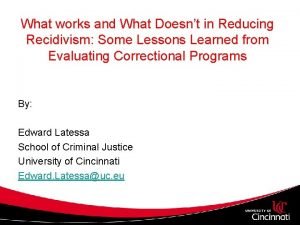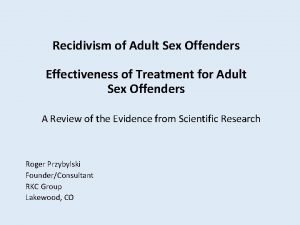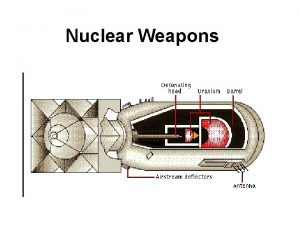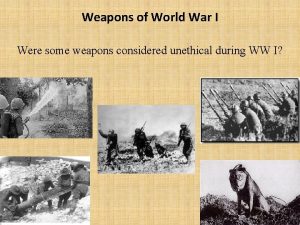Some findings concerning recidivism among weapons offenders Presented










- Slides: 10

Some findings concerning recidivism among weapons offenders Presented CJPAC September 2010

Recidivism among weapons offenders BOPP Chairman Robert Farr requested information on the recidivism rates of weapons offenders compared to offenders that had no record of weapons offenses. The analysis was used OPM’s existing dataset for 16, 241 sentenced offenders who were released or discharged from prison in 2005. We tracked 3 -year recidivism rates for offenders with any illicit weapons history prior to their 2005 -release.

Recidivism among weapons offenders Finding 1: Offenders with a history of incarceration on weapons charges recidivated at higher rates than other offenders.

Recidivism among weapons offenders Recidivism rates among weapons offenders were higher for each recidivism type and for every window of time.

Recidivism among weapons offenders Combined, the 1, 911 weapons offenders in the study served a total of 2, 612 separate sentences for weapons offense. Although offenders’ sentences ranges across almost different weapons statutes, most common eight (8) statutes accounted for 87% of all weapons sentences.

Weapons offenders – arrest, conviction & incarceration Finding 2: The population of offenders with a history of weapons use or possession was higher than we anticipated. Of 14, 391 sentenced males who were released or discharged in 2005, • 13% had served a prison sentence for a weapons offense • 16% had been convicted of a weapon offense, and • 30% had been charged with a weapons offense at arrest

Weapons offenders – arrest, conviction & incarceration Finding 3: Proximity to illegal weapons, not conviction, is a predictor of recidivism. The recidivism rates of weapons offenders were remarkably consistent regardless of whether the offender had been sentenced (67%), convicted (66%), or only arrested on a weapons offense (65%).

Weapons offenders and risk Finding 4: Involvement with weapons and risk of recidivism were closely linked. • Among 2, 798 male offenders with the lowest TPAI scores (scores of 1 to 3) only 2% had ever been sentenced to prison for a weapons charge. • Among 1, 625 male offenders with the highest risk scores (scores of 7 or 8) 36% has served a prison sentence for a weapons offense.

Weapons offenders and other charges • Only 13% of weapons offenders had not served a prison sentence for either a drug crime, a property crime or a violent felony. Among weapons offenders: 41% also served sentences for felony violence; 65% for drug offenses, and 44% had served sentences for property crimes.

John Forbes Asst. Director, OPM, CJPPD John. Forbes@ct. gov Ivan Kuzyk, Director CT Statistical Analysis Center Ivan. Kuzyk@ct. gov www. ct. gov/opm/Criminal. Justice/Research
 Recidive
Recidive What works and doesn't in reducing recidivism download
What works and doesn't in reducing recidivism download Young offenders act
Young offenders act Youthful offenders act 1854
Youthful offenders act 1854 Cognitive behavioral therapy for sex offenders
Cognitive behavioral therapy for sex offenders Borstal institution meaning
Borstal institution meaning According to choice theorists, offenders:
According to choice theorists, offenders: For adult sex
For adult sex Juvenile delinquency graphic organizer
Juvenile delinquency graphic organizer Icecream countable or uncountable
Icecream countable or uncountable Force and motion
Force and motion


















